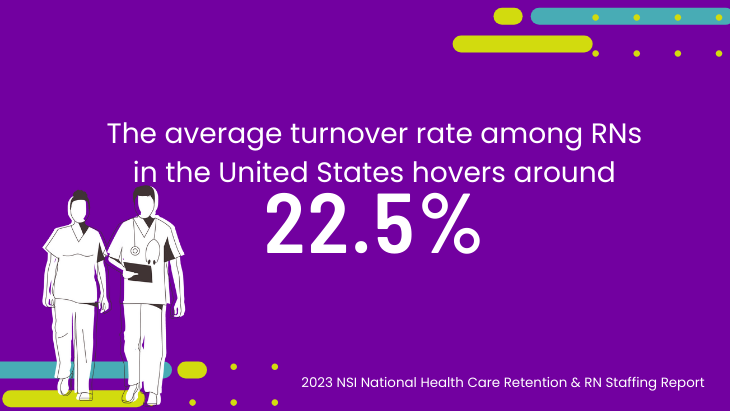Revolutionizing the Healthcare Workforce: Innovative Strategies for Nurse Retention, Work-Life Balance, and Diversity & Inclusion

The healthcare sector has long grappled with a multitude of challenges, from an ever-growing demand for quality care to the constant need for innovation in medical practices. Among these challenges, three critical issues stand out: nurse retention, work-life balance, and diversity and inclusion. The significance of these challenges cannot be overstated, as they not only affect the well-being of healthcare professionals but also impact the quality of care provided to patients.
David Mafe, the Chief Diversity Officer at UCHealth, recently shared his insights and expertise to tackle these issues. David revealed six pivotal facts about the nursing workforce, including a decline in the commitment of bedside RNs and the imperative need for work-life balance. He emphasized a systematic approach to managing the healthcare workforce, including reskilling, role redesign, recruitment, retention, and active listening to frontline staff. This article explores these innovative strategies to revolutionize the healthcare workforce.

The Nurse Retention Challenge
The impact of nurse turnover on healthcare is multifaceted and far-reaching. Current nurse turnover statistics paint a grim picture, with a notable decline in the commitment of bedside Registered Nurses (RNs). According to recent data, the average turnover rate among RNs in the United States hovers around 22.5%, significantly higher than the national average for all industries. This disrupts the continuity of patient care and places a substantial burden on healthcare organizations.

Beyond the obvious challenges of recruiting and training replacements, frequent turnover disrupts patient care continuity, leading to lower patient satisfaction and compromising the quality of healthcare services. Moreover, it strains the financial resources of healthcare organizations as recruitment and onboarding costs soar. The perpetually revolving door of nursing staff also places an added burden on the remaining employees, increasing their workload and, consequently, the risk of burnout and decreased job satisfaction.
Reskilling and Redesigning Shifts
One innovative strategy to combat nurse turnover and enhance nurse retention involves the concept of reskilling. It’s crucial for nurses to continually expand their skill sets to meet the diverse and changing needs of patients.
Reskilling programs offer nurses the opportunity to acquire new competencies, such as learning to operate advanced medical equipment, providing specialized care, or developing leadership skills. By investing in reskilling initiatives, healthcare organizations empower their nurses with a broader skill set and demonstrate a commitment to their professional growth and development. This can foster a sense of loyalty and purpose among nurses, making them more likely to stay with their current employer.
Redesigning shifts is another innovative approach that can impact nurse retention by improving work-life balance. Traditionally, healthcare schedules have been known for their demanding hours and shifts, often leading to burnout and job dissatisfaction. By redesigning shift patterns, healthcare organizations can better accommodate the personal lives of their nursing staff, allowing for more predictable and flexible work hours. This improves nurses' job satisfaction and contributes to better mental and physical health, ultimately reducing turnover rates.
Promoting Work-Life Balance
Work-life balance is a cornerstone of nurse retention and overall well-being. Nurses, like all healthcare professionals, face tremendous pressure in their roles, often working long hours and dealing with emotionally taxing situations. Achieving a healthy work-life balance is essential for their mental and physical health, job satisfaction, and, ultimately, the quality of patient care.
To promote well-being in healthcare, nurse work-life balance strategies can be implemented:
Flexible Scheduling: Organizations should adopt flexible scheduling practices that allow nurses to have more control over their work hours. This can include offering part-time or job-sharing arrangements, allowing nurses to choose shifts that suit their personal needs, and providing advanced notice for scheduling changes.
Paid Time Off: Offering paid time off, including vacation and personal days, is crucial to ensure nurses have the opportunity to rest and recharge.
Self-Care Initiatives: Encouraging self-care initiatives and providing access to counseling services can also contribute to nurses' overall well-being.
Supportive Environment: Creating a supportive work culture that values work-life balance, provides resources for stress management, and actively seeks feedback from nurses to make necessary improvements is fundamental to retaining a satisfied nursing workforce.
Diversity and Inclusion in Healthcare
The imperative for diversity and inclusion in healthcare extends far beyond mere checkboxes on an organizational chart. It's a moral obligation and a strategic necessity. A diverse healthcare workforce reflects the varied patient populations they serve and brings a wealth of perspectives, experiences, and cultural competencies that enhance the quality of care. For healthcare organizations, fostering DE&I isn't just about compliance; it's about improving patient outcomes and creating a more equitable healthcare environment.
One of the key benefits of diverse healthcare teams is their ability to provide culturally sensitive care. Patients from diverse backgrounds often have unique healthcare needs and expectations rooted in their cultural, social, and linguistic contexts. Healthcare teams that mirror this diversity are better equipped to understand and address these nuances, leading to improved patient satisfaction and better health outcomes.
Moreover, diverse teams tend to be more innovative, drawing from a broader pool of experiences and perspectives to solve complex medical challenges. This drives progress in medical research and practice and enhances the quality of healthcare. Inclusion, which goes hand in hand with diversity, ensures that every member's voice is heard, fostering collaboration and trust among staff, ultimately benefiting both patients and healthcare organizations.
Fostering Diversity and Inclusion
To truly revolutionize diversity and inclusion within healthcare, organizations must implement innovative strategies that go beyond just meeting diversity quotas. One promising approach is to establish mentorship and sponsorship programs that connect underrepresented healthcare professionals with mentors who can provide guidance and support in navigating their careers. These programs create a supportive network, helping individuals from diverse backgrounds to thrive in their roles and climb the career ladder.
Inclusive leadership is another pivotal aspect of fostering DE&I. Healthcare organizations should prioritize the development of leaders who champion diversity and actively work to create inclusive environments. These leaders should lead by example, ensuring that DE&I principles are embedded in all organizational practices. Furthermore, investing in comprehensive diversity training programs for all staff members can help raise awareness, promote understanding, and eliminate biases. These programs should be ongoing, reflecting the evolving landscape of DE&I and ensuring that healthcare professionals continuously expand their cultural competencies.
Challenges and Opportunities
Implementing innovative strategies in healthcare, such as those aimed at nurse retention, work-life balance, and diversity and inclusion, can be met with several challenges in healthcare innovation. One of the primary hurdles is resistance to change within the healthcare system, which often operates on deeply ingrained traditions and practices. Overcoming resistance to new approaches and paradigms requires strong leadership, effective communication, and a willingness to address the fears and concerns of healthcare professionals.
Healthcare organizations that successfully tackle nurse retention and work-life balance issues can expect to see reduced turnover rates, increased job satisfaction, and a more resilient and dedicated nursing workforce. Embracing diversity and inclusion not only enhances patient care but also fosters a more innovative and inclusive healthcare culture.
Moreover, as healthcare continues to evolve, organizations that adapt and champion these strategies will be better equipped to meet the diverse needs of patients. By recognizing the challenges and seizing the opportunities, healthcare institutions can truly revolutionize their workforce, creating a brighter future for healthcare professionals and the patients they serve.
Embrace Innovative Strategies to Boost Nurse Retention
Innovation in healthcare is not confined to groundbreaking medical treatments and technologies; it also extends to the strategies employed in managing the healthcare workforce. Nurse retention, work-life balance, and diversity and inclusion are critical facets of healthcare excellence. The pressing challenges in healthcare staffing demand innovative solutions that prioritize the well-being of healthcare professionals and the quality of patient care.
It is paramount that healthcare organizations embrace these innovative strategies. By investing in nurse retention initiatives, fostering work-life balance, and championing diversity and inclusion, they ensure the sustainability of their workforce and position themselves as leaders in the field. The benefits are multifold: improved patient outcomes, enhanced staff satisfaction, and a more resilient, adaptable, and compassionate healthcare system.